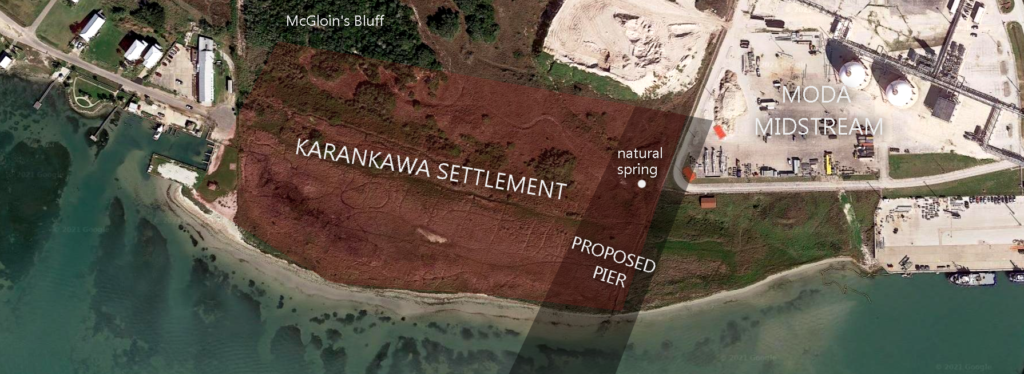
A History of the McGloin’s Bluff Karankawa Settlement:
From roughly the 1300s to the 1700s, Karankawa Indians repeatedly inhabited what is today known as McGloin Bluff. Archaeological evidence indicates that these First peoples established a settlement around four football fields in length along Corpus Christi Bay. Around 250 years later, in 1957, an unknown individual told archaeologist James E. Corbin of “an Indian mound in the area.” When Corbin investigated the area, he located an abundance of artifacts (ultimately more than 3000) resting on the surface. Thereafter the site was given the Smithsonian trinomial 41SP11, or state number 41 (Texas), county (San Patricio), and county site number (11). From 1987 to 1992, the U.S. Navy constructed a base next to this former Karankawa settlement and almost inevitably built over the eastern-most portion of this seasonal village.
In 2004, archaeologist Robert Ricklis and his team completed an extensive survey of the western portion of the McGloin Bluff site at the behest of the Corpus Christi Port Authority, which owns most of the land. Ricklis found an incredible number of artifacts, so many, in fact, that the site was recommended for listing on the National Registry of Historic Places and as a Texas State Archaeological Landmark. 41SP11 west achieved TSAL recognition.
In 2006, Ricklis and team decided to survey the remaining eastern portion of the McGloin Bluff settlement. They found a good number of artifacts, but the western portion by comparison had nearly 10 times more items. Ricklis concluded that the eastern side was not eligible for the same protections as the western side. Around this time, the U.S. government decided to move the Ingleside Naval Base to San Diego. This process of transporting battle cruisers, aircraft, and personnel took five years, and when that was achieved, the government gave the property back to the Corpus Christi Port Authority.
In 2008, the Port of Corpus Christi, likely recognizing that they would have to put the McGloin Bluff property up for sale because of the military base’s relocation, requested a “data recovery” of the western part of the uncovered Karankawa village. The purpose of a data recovery is to gather all possible artifacts and faunal remains and to store these objects at universities and other labs for future study. TRC Environmental Corporation unearthed 40,000 artifacts, more than 100 arrowheads, “thousands” of animal bones/otoliths, and a handful of material of European origin.
When the data recovery project was formally completed in 2010, the Texas Historical Commission informed the Port of Corpus Christi that “all of the 423-acre property inclusive of 41SP11 has been cleared for construction.” That same year, the Port sold the former naval base to Occidental Petroleum (OP). OP’s property includes a section of the eastern McGloin Bluff Karankawa site. In 2018, Moda Midstream acquired the Ingleside property from OP. In January 2019, Moda announced pier and terminal upgrades that involved the destruction of the eastern portion of the McGloin Bluff Karankawa settlement—a location that assuredly still holds a sizeable number of artifacts. In October 2021, Canadian pipeline operator Enbridge Inc. completed its purchase of Moda Midstream for three billion dollars. Enbridge has continued Moda’s destructive policy.
If you can contribute to this history, please contact us. For an event timeline of all of the sources in relation to 41SP11, see https://docs.google.com/spreadsheets/d/1Y8MNovrWVz5BfaE23o20dKOxm5vqoxXSbG5kGg3G9c0/edit?usp=sharing.